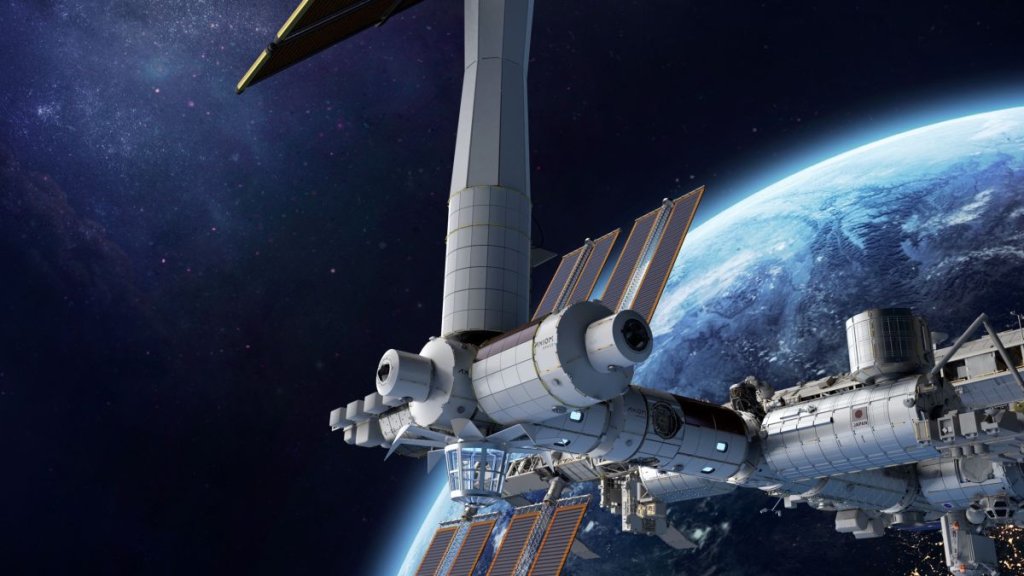Axiom Space has big plans for low Earth orbit.
The Houston-based company, founded in 2016, was the first to ferry a flight of all private citizens to the International Space Station (ISS) aboard the Ax-1 mission, which launched in April 2021. The company’s second flight (Ax-2) to the ISS wrapped up an eight-day mission in late May with the splashdown and safe return of the contracted SpaceX Crew Dragon capsule and a privately funded crew of four. A third flight, Ax-3, is currently scheduled for this November. Each mission has included a host of science experiments for its crews to conduct, and Axiom is using some of those investigations to inform the design and use of the company’s own space station.
In January 2020, Axiom won NASA’s contract to construct the first commercially manufactured module for the ISS. “Our first module is going to be in 2026,” David Zuniga, senior director of in-space solutions at Axiom, told Space.com. This is an update to the company’s previously stated target of 2024.
Related: Axiom Space: Building the off-Earth economy
Axiom’s first station component will attach to the forward port of the ISS’ Harmony module and serve as the springboard for the remaining pieces of the company’s planned space station architecture. Axiom is planning to attach a second module in 2027 and a third module a year later. Finally, a thermal power module, scheduled for sometime before 2030, will allow Axiom’s space station to detach from the ISS and become a free-flying, commercially run low Earth orbit (LEO) destination.
In the meantime, Axiom is using data provided by its crewed missions to the ISS to guide the form and function of the space station modules the company is building. “Each of these precursor missions for us is a learning opportunity on how we become a better human spaceflight company,” said Tejpaul Bhatia, Axiom’s chief revenue officer.
These first missions are also helping to lay the foundations for Axiom’s training programs going forward. “We are using these first missions as a way to understand how to train astronauts, train crew, and really have the operational expertise that we need as an entire company, but also to kind of fine-tune the things that we want to fly from a low-Earth-orbit economy perspective,” Zuniga told Space.com.
One research project included on Ax-2 was the Translational Research Institute for Space Health (TRISH) Essential Measures investigation, which involved a checklist of tests for the Ax-2 crewmembers to perform on themselves upon reaching orbit. Physical evaluations, biological sampling and wearable devices were used to evaluate the crew’s reaction and adaptation to microgravity.
Most Axiom crewmembers lack the multiple years of extensive training that NASA astronauts receive in preparation for their time in space. (Notable exceptions include former NASA astronaut Peggy Whitson, who commanded Ax-2 and has spent more hours in space than any other American or woman, and former NASA astronaut Michael López-Alegría, who commanded Ax-1 and holds the record for the most spacewalks ever performed.) The TRISH investigation is one way Axiom is learning how to acclimate crews to their new microgravity environment and creating strategies to mitigate the time it takes them to adapt.
Axiom wants its space station to provide maximum value to its passengers, and one main goal of these initial crewed missions to the ISS is to determine where that value will be.
“It’s more about making sure that we understand the needs of our future crews so that we’re tailoring our space station to do those things,” Zuniga said. “Is it going to be the microgravity research? Or is it going to be in space manufacturing, etc.? Those are the primary goals for flying these precursor missions.
“In doing that, it gets all our people exposed to how we actually operate and build a station that will be operable in the future,” he added. “Thinking about the amount of crew activity that goes on, thinking about the amount of operational space that a crewmember has to apply to a space station so that they can keep it up and flying and maintaining it — all those things are really important in understanding how we design our future space station.”
Axiom is also taking notes directly from NASA on how to build space stations. “Our team is well versed in human spaceflight,” Zuniga said. “We’ve just been able to kind of pull the talent that we needed from folks who have built and designed space stations.”
In doing so, the company has kept an eye toward the future. “We’re working with NASA to make sure that we follow all the requirements that the ISS has today, so that we can build our models for the future to those requirements,” Zuniga said. “All of that is also giving us exposure to make sure that we design our space station so that it’s compatible to today’s standards, but also has a vision to the future and how we want to use space stations for people that will fly privately.”
Axiom isn’t the only company interested in the LEO economy. Nearly two years after NASA selected Axiom to dock its space station module to the ISS, the space agency awarded development contracts to three more companies — Blue Origin, Nanoracks and Northrop Grumman — to support the creation of additional commercial LEO destinations.
NASA is committed to maintaining the ISS through 2030 but expects the emerging market of private space stations to fulfill the agency’s continued presence in LEO. That aligns with Axiom’s timeline to launch its station’s own power module and undock from the ISS before its retirement.

